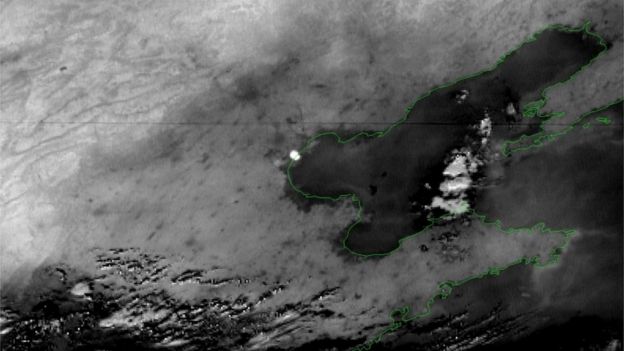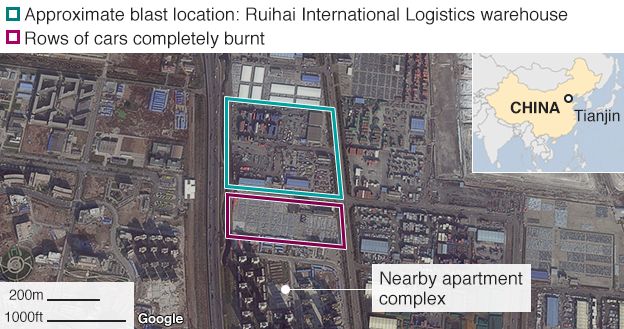
Two massive explosions in the port of Tianjin, northern China, have killed dozens of people, left hundreds injured and devastated large areas of the city.
Much of what took place, or is still happening now, is unclear - but here is what we do know.
How did the blasts happen?
They took place at a warehouse at the port which was reportedly storing "dangerous and chemical goods". The building is owned by Tianjin Dongjiang Port Ruihai International Logistics the explosions, many firefighters were already at the scene trying to control a blaze, AFP reports.
There have been suggestions that water sprayed on some of the chemicals could have led to the blasts.
Calcium carbide, known to be at the site, reacts with water to create the highly explosive acetylene.
Chemical experts suggest an acetylene blast could then have detonated ammonium nitrate for a much larger blast.
Profile of Tianjin city

How big were the explosions?
The China Earthquake Networks Centre said the initial explosion, in a city with a population of nearly 7.5 million. had a power equivalent to three tonnes of TNT detonating, while the second was the equivalent of 21 tonnes.
The second was so big that satellites orbiting Earth picked it up as well. Chinese data site Cnbeta published pictures showing the sudden flare.

How bad is the devastation?
The explosion destroyed a significant amount of goods stored at and around the port, in the Binhai New District.
Large shipping containers were tossed into the air like matchsticks and were crumpled by the blasts.
A logistics park containing several thousand cars was incinerated by the fireball. Renault says some 1,500 of its cars were lost, while Hyundai said it had around 4,000 cars on the site - although it has not yet assessed the level of damage.

The blasts rippled out several kilometres from the port into residential areas.
The impact rocked entire buildings, shattered windows and tore doors off their hinges.
More than 720 people were taken to hospital, of whom nearly 60 are either critically or seriously injured. Reuters reports that several thousand people living near the port have had to leave their homes, and are now staying in local schools.
Jump media pla

How are the blasts being dealt with?
Chinese media say more than 1,000 firefighters are still at the scene, with some fires still burning.
More than 200 chemical and biological experts from the military are on site.
President Xi Jinping and Premier Li Keqiang have vowed to hold a thorough investigation and ensure "open and transparent information disclosure to the public".

China has also ordered a nationwide check on dangerous chemicals and explosives.
In a report, Xinhua said the cabinet, the State Council, had ordered "governments at all levels to reinforce the safety management".
They should "firmly implement special regulatory measures for highly toxic chemicals such as cyanide, as well as inflammable and explosive materials".
Is it safe?
Reuters reported that, according to a 2014 government assessment, the Ruihai facility was designed to store chemicals including butanone, an explosive industrial solvent, sodium cyanide and compressed natural gas.
The company also reportedly handles toluene diisocyanate, which is used in the production of flexible polyurethane foams.
Officials have confirmed that calcium carbide, potassium nitrate, ammonium nitrate and sodium nitrate were at the warehouse.
Police have also confirmed that sodium cyanide was present near the site. It is soluble in water and, when dissolved or burned, it releases the highly poisonous gas hydrogen cyanide.
You can read more about the toxic chemicals believed to be at the site here.
Xinhua said on Thursday that drains from Tianjin to the Bohai sea - a gulf in the Yellow Sea - had been closed "to stem a chemical leak".
One official on Friday insisted the "air and water in Tianjin is safe", but on Saturday the authorities ordered the evacuation of a 3km radius around the site.

What impact will this have on Tianjin port?
Tianjin is a significant industrial port near Beijing, and is a gateway for goods going in and out of the capital and the industrial north of the country. It is also a main trading hub for metals and steel.
The port remains partially open as the explosion was contained in one section.
But authorities have imposed stringent checks and movement in and out of the port has slowed down, which is likely to affect some industries, the Mysteel.com news portal reported.
Mining giant BHP Billiton said its port operations and shipments had been disrupted, although its iron ore discharging berth was undamaged.

Blogger Comment